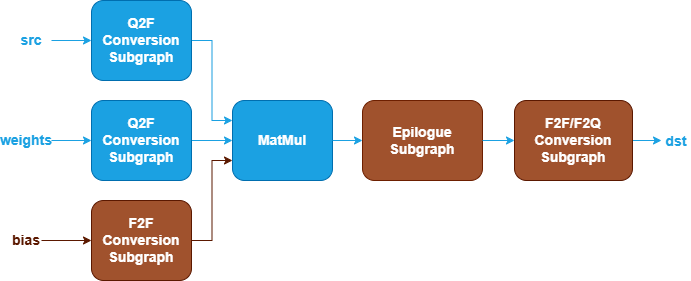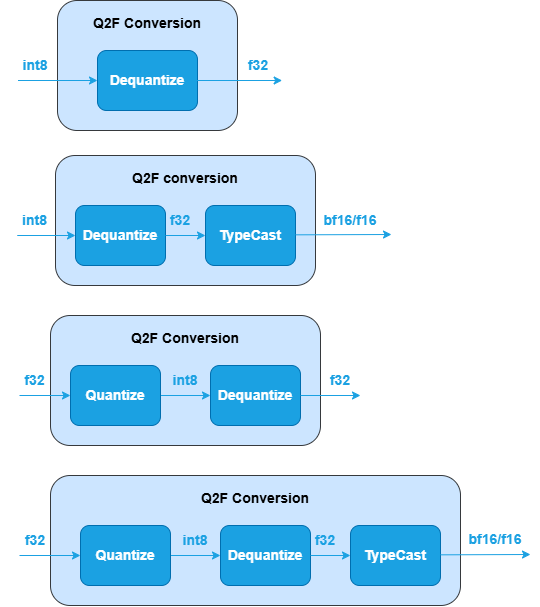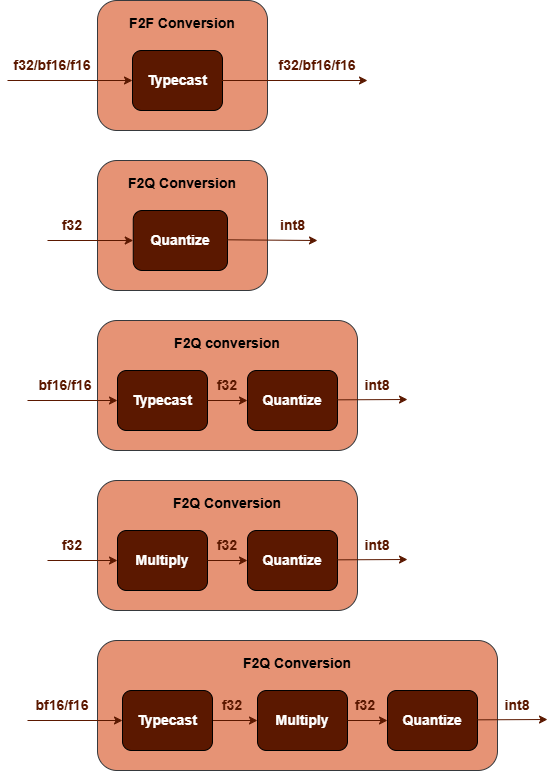Quantized MatMul Fusion Patterns#
Overview#
oneDNN supports both floating-point and quantized MatMul fusion patterns to optimize performance and reduce memory bandwidth requirements. This document describes the supported quantized fusion patterns for MatMul. For floating-point MatMul fusion patterns, refer to MatMul Fusion Patterns for more details.
Pattern Structure#
oneDNN defines quantized MatMul fusion patterns as follows. The blue nodes are required when defining a quantized MatMul fusion pattern while the brown nodes are optional.

Q2F Conversion Subgraph : Converts
srcandweightstensors from quantized to floating-point. It can be one of the following subgraphs, while the last two subgraphs apply only toweights. See Dequantize, TypeCast and Quantize operations in Graph API.
F2F Conversion Subgraph : Converts
biastensor from floating-point to another floating-point. It is constructed by a TypeCast operation.
MatMul Operation : Performs matrix multiplication between the
srcandweightstensors. Thebiastensor is optional. See the MatMul operation in the Graph API for more details.Epilogue Subgraph : Optional and can include the following operations:
BiasAdd operation.
Binary and Unary operations: refer to the Note in Fusion Patterns.
Select operation.
Combination rules:

BiasAdd : If present, must be the first op in the epilogue subgraph and can only appear once.
N=20, 0 to 20 Binary or Unary operations are supported in the epilogue subgraph.
Select : If present, must follow binary/unary operations (if present) and can only appear once.
F2F/F2Q Conversion Subgraph : Converts the output tensor from floating-point to floating-point or quantized data type. It can be one of the following subgraphs, the last two subgraphs are implementations for SmoothQuant[1]. See TypeCast, Quantize and Multiply operations in Graph API.

Data Types#
oneDNN supports the following combinations of data types for src, weights, bias and dst:
src |
weights |
bias |
dst |
|---|---|---|---|
u8,s8 |
s8,f32 |
f32,bf16,f16 |
u8,s8,bf16,f16,f32 |
The definition of the data types and support status on different CPU and GPU platforms follow the general description in the Data Types Guide.
Limitations#
F2F Conversion Subgraph used for
biastensor only supports f32 to bf16 data type conversion.
Reference#
[1] SmoothQuant, https://arxiv.org/abs/2211.10438
